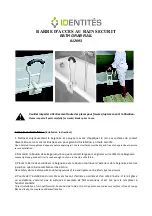
Maintenance
8 Maintenance
8.1 Daily performance check
Check that the following parts are correctly mounted on
the wheelchair:
•
Wheels
•
Backrest
•
Anti-tip device
•
Push handles
•
Footrests
8.2 Safety information
Regular checks and maintenance of the wheelchair ensure
the user’s safety and the expected lifetime of the chair.
8.3 Cleaning
•
Wipe metal parts and the upholstery regularly with a
damp cloth.
•
A mild detergent can be used.
•
If necessary, the upholstery can be washed at 60º C.
•
Ordinary washing powder/liquid can be used.
•
For disinfection only use alcohol based detergent.
Only use water and soft soap to clean the table!
8.4 Washing and disinfection
1.
Remove all loose and removable covers and wash
them in a washing machine according to the washing
instructions for each cover.
2.
Remove all padded parts such as seat cushions, armrests,
headrest/neckrest with fixed padded parts, calf pads
and so on and clean them separately.
The padded parts can not be cleaned with a
high-pressure cleaner or water jet.
3.
Spray the wheelchair chassis with detergent, for example
a car-cleaning agent with wax, and leave on to work.
4.
Rinse the wheelchair chassis with a high-pressure
cleaning or ordinary jet of water depending on how dirty
the wheelchair is. Do not aim the jet towards bearings
and draining holes. If the wheelchair chassis is washed
in a machine the water must not be hotter than 60º C.
5.
Spray the wheelchair chassis with alcohol for disinfection.
Only use water and soft soap to clean the table!
6.
Leave the wheelchair to dry in a drying cabinet. Remove
parts where water has collected for example in end
tubes, ferrules etc. If the wheelchair has been washed
in a machine, blow-drying with compressed air is
recommended.
Dartex
®
Lighter stains on the fabric may be neutralized with a soft
damp cloth and some neutral detergent. To neutralize
larger, more persistent stains, wipe the fabric with alcohol
or turpentine substitutes, and wash with hot water and a
neutral detergent.
Proprietary disinfectants may be used, provided that the
manufacturer’s instructions are followed. The fabric can
be washed at temperatures up to 71º C (160º F). Normal
detergents can be used.
All parts of the wheelchair with Dartex® upholstery,
such as armrest pads, calf pads, headrest/neckrest,
should be cleaned according to the instruction above.
8.5 Maintenance schedule
Check....
Weekly
Monthly
6 months
Action:
Recommended air pressure for rear wheels:
Standard tires
3.5 bar
50 psi
Recommended air pressure for castors:
Low profile tires
8”
4.0 bar
Tire pressure
X
QR axles rear wheels
X
Pull on the rear wheel to check that the removable
axle does not come off.
All fasteners for wear and
tightness
X
Bolts and other fasteners can come loose due to
constant use.
1.
Check that the fasteners are tight on the castor
forks, footrest, seat, side supports, backrest,
handles etc.
2.
Tighten any loose bolts.
Castors
X
1.
Check that the castors turn freely.
2.
Remove any dirt and hair.
Anti-tip devices
X
Check that the anti-tip device is easy to adjust and
fold.
1439960-D
27






































